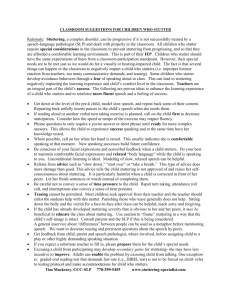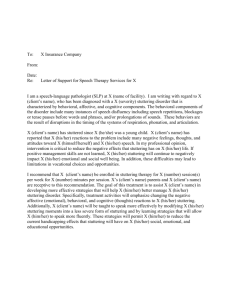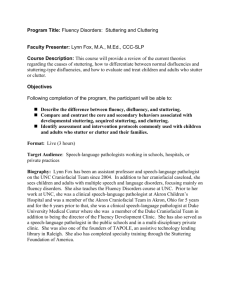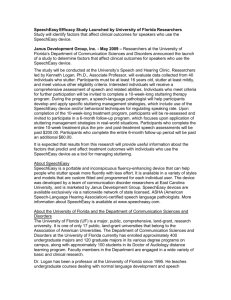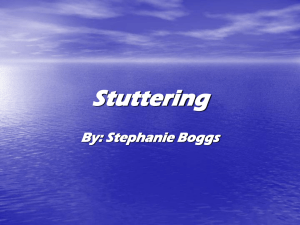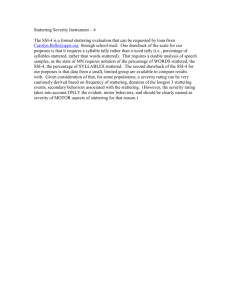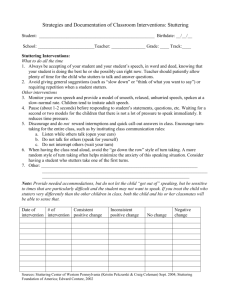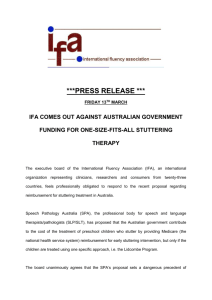Objectives and Activities
advertisement
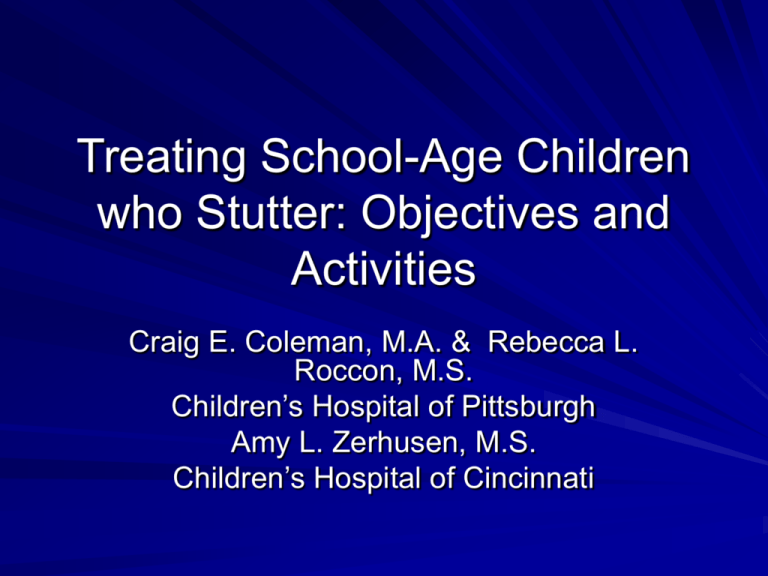
Treating School-Age Children who Stutter: Objectives and Activities Craig E. Coleman, M.A. & Rebecca L. Roccon, M.S. Children’s Hospital of Pittsburgh Amy L. Zerhusen, M.S. Children’s Hospital of Cincinnati Common Misconceptions Only number of disfluencies can be measured Reduction of disfluencies is the only goal Criteria used in articulation/phonology can be applied to stuttering (80% fluent speech) Affective responses will improve on their own, as the child’s fluency improves Appropriate Goals Goals should address all aspects of the disorder, not just the number of disfluencies Goals should be geared toward increasing the overall communication skills of the person who stutters – Is it better to speak freely and stutter or avoid situations/words that may be problematic? Target the “quantity” AND “quality” of stuttering Goals should be individualized Goals to Address Education Children need to be educated about stuttering (Empowerment) Education helps the child deal with stuttering long-term rather than getting a “quick fix” Helps the child teach others, such as their peers, about stuttering Goals to Address “Quality” of Stuttering These goals should target decreased physical tension during stuttering Kids can learn that they sometimes can’t control “if” they stutter, but they can control “how” they stutter Goals here should also target reduction of secondary behaviors These are often stuttering modification techniques Goals to Address “Quantity” of Stuttering These goals are speech modification techniques They target reduction of the number of disfluencies Important to note that “quantity” and “quality” are not exclusive goals-one often ties in with the other Goals should be viewed in terms of reduction, not how often children can speak fluently Goals for Targeting Overall Communication These are the most important goals because they target communication Helping the child become a more effective communicator is the primary goal of treatment Goals should heavily target avoidance or negative reactions to stuttering Getting to know your patient Interests Motivation Family dynamics Understanding their needs Is fluency their number one priority? Do they have other medical diagnosis? Fluency Treatment Activities Don’t Break the Ice Fluency Olympics Fluency Slogan Don’t Break the ice Pictures taped on top of the ice cubes Take turns giving directions Use fluency shaping: Easy relaxed speech Use stuttering modification: Pseudostutter Fluency Olympics “Stations” around your therapy room One station outside of the therapy room Varying levels of fluency shaping and stuttering modification tasks Child leaves the room to complete one station Fluency Slogan Adopted VISA/MASTERCARD slogan “One hour of speech therapy, $130; asking your parents to order dinner for you, getting the sandwich that you hate; feeling good about stuttering, priceless.” Fluency Slogan Brainstorm-How fluency affects the child’s life Develop own fluency slogans Helps to desensitize, lessen negative thoughts about stuttering Around the World Child is given an atlas Child picks a location Child describes location (fact or fictional) – Climate – Geography – Planning a trip to the location Example Jamaica – Climate: hot, partly cloudy (e.g. 88o F / 31o C) – Geography: Jamaica is dominated by mountains, mostly covered with lush, green forests. Blue Mountain is the highest point, at 7,402 feet. – Planning a Vacation 7 day tour of white beaches, enjoy local Reggae music, culture, and food Therapy Targets Speech Modification – Climate Easy starts (at sentence level) – Geography Pausing and phrasing (e.g. There are / many mountains/ in Colorado) – Vacation Target easy starts and pausing/phrasing at conversational speech level Stuttering Modification – Climate Pull-outs and cancellations at the word level (e.g. cold) – Geography Target at sentence level – Vacation Target at conversational speech level Other Therapy Targets Purposeful Stuttering – Climate Prolongations – Geography Repetitions – Vacation Blocks Movie Review Child and clinician watch stuttering movie/clip Clinician provides child with movie review worksheet Child and clinician discuss the worksheet following the movie Movie Review 1.What did you like the most about the movie? 2.What did you like the least about the movie? 3.Were there any comments made by the speakers that you could relate to? 4.Have you ever been teased about your stuttering? If so, what did you say in response? 5.If you have never been teased about your stuttering, what might you say if you were? 6.How much do you know about stuttering? 7.List 2 things you know about stuttering. 8.List 2 things you would like to know about stuttering. Therapy Targets Questions 1 & 2 – Target speech modification (e.g. easy starts) or stuttering modification (e.g. cancellations) in responses Questions 3, 4, & 5 – Target reactions to stuttering (e.g. feelings and emotions towards stuttering and responses to teasing) Questions 6, 7, & 8 – Target knowledge of stuttering (e.g. facts and questions related to stuttering) Name That Category Clinician identifies category and child identifies members of that category – E.g. Things with wheels Cars, bus, motorcycle Activity can be reversed where the clinician provides the members of the category and the child then identifies the category Example Things that are round – Ball – World – CD Things that are soft – Pillow – Stuffed animal – Clothing Things that are round and soft – Cotton ball – Foam ball – Ear muffs Stuttering & Language Excellent activity for those children with co-occurring language deficits – Provides opportunities to practice stuttering modification or speech modification strategies across all levels (e.g. word, phrase, conversational) – Provides opportunities to address word finding or language formulation deficits Therapy Targets Speech Modification – Clinician provides the members of the category – Child identifies category, as well as, describes how the members are related Pausing/phrasing at the phrase and/or conversational level Stuttering Modification – Child identifies member of the category Cancellations or pull outs at the single word level The Great Debate Have your students participate in debates with their peers--or with you You can pretend that you are debating with the child to see who would make a better Class President of their school The “winner” of the debate is decided by a points system, which rewards one point for each of the following: – appropriate eye contact – speech modification or stuttering modification strategies (e.g., easy starts, pausing and phrasing, or even voluntarystuttering) – the content of the response. Each participant in the debate is given their own turn to answer questions. This gives them a chance to talk without being interrupted. In addition to allowing the child to work on several objectives in a natural context, this activity also promotes an awareness of time pressure and turntaking Pick Your Team Children pick five to six players from professional sports teams that they want to include on their team They get to select their team name and make uniforms Following the selection of players, the child is told to pretend that each person on his team now stutters The child must come up with a list of team “rules” to facilitate communication on a team of players who stutter Helps children verbalize their beliefs about stuttering Helps them learn appropriate behavior when interacting with those who stutter Sample Team Rules Don’t tease others who are stuttering If someone is teasing you, tell a coach Use your speech tools Maintain eye contact Say what you want, even if you stutter Have team meetings to learn about stuttering Help people on the team if they are being teased by someone else Stuttering Football Helps children learn the facts about stuttering Children can play against others who stutter or against their parents Each player starts at the goal line and tries to make it 100 yards to the other end zone to score Each person takes turns selecting the number of yards they want to go for. The higher number of yards, the harder the question they are asked by their opponents! If they get the question right, they get to move up that many yards If they get the question wrong, they do not advance and the other team gets their turn! You can use this activity with a group of kids by dividing them into teams They can discuss the questions they will ask (and determine how much each question is worth) Time to Share… What are some activities that you have found helpful with children who stutter? Are there questions about specific cases?

